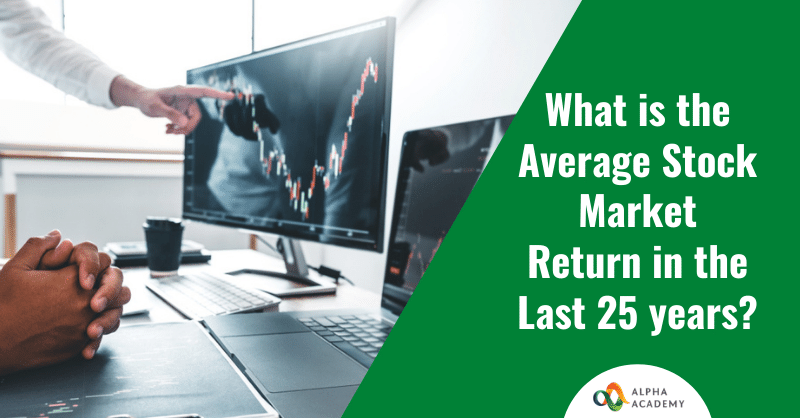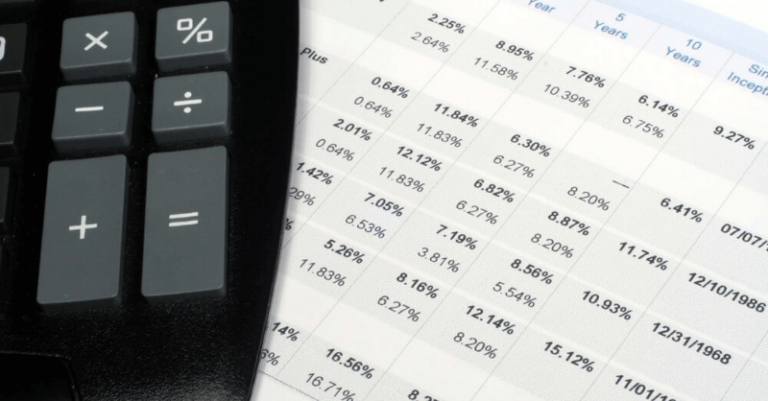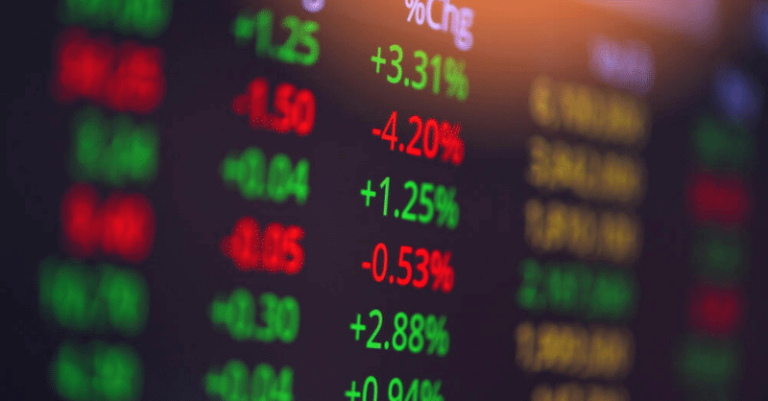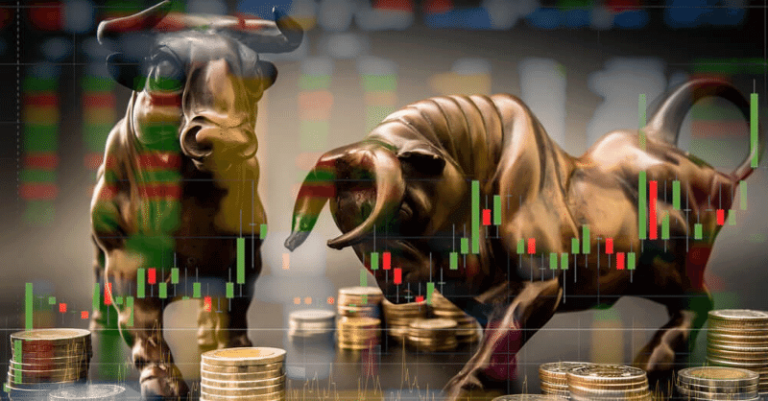

People invest in the stock market to get a good return. And you can easily determine that by looking at the average stock market return in the last 25 years. Usually, a good return on investment is between 3% to 7% per year.
This article will provide you with all the details on the average stock market return in the last 25 years. And we’ll also discuss the negative market and factors that impact the stock return. So, let’s get started!
Table of Contents
What is a Stock Market Return?
A stock market return refers to the profit, dividend, or both that an investor receives in their investment. To understand stock market returns last 25 years, we need to know why the stock market fluctuates.
The share price of a company might increase or decrease depending on various factors. For instance, supply vs demand, market sentimentality, changes in revenue, political issues, etc. All these factors have the capability to influence the average rate of return on stocks an investor realises.

Moreover, seemingly unconnected financial factors like increasing trade tariffs between two nations can impact the valuation of certain stocks in an interconnected economy. Because of the volatility of the stock market, emerging global events and sudden inflations can also influence it. Changes in the prices of goods and commodities have a major impact on the stock market.
Hence, looking at a single stock and then applying the knowledge to the market at large may help investors understand the fluctuation.
Factors Impacting Average Stock Market Return
in the Last 25 Years
There are numerous factors affecting the value of stocks and the average return on stocks for investors. For instance, the UK airline industry relies in part on leisure travel discretionary spending. It refers to consumers paying for flights that they do not need to take.

However, sometimes trade wars might lead to less available money in British consumers’ pockets. In that situation, the market reacts out of fear of a future decline in sales or concern for the increasing cost of doing business. This is what we call market sentimentality, which can negatively affect a stock’s value.
When multiple companies’ share prices fluctuate simultaneously, the stock market as a whole swings up or down. Additionally, numerous big businesses’ shares drop when trade wars affect various companies’ production overseas. It could also drop due to the linear effect of consumers’ ability to spend. As a result, the market dips.
However, stocks can rise back up when tariffs on imports and exports ease. That is because traders can anticipate reduced costs passed on to consumers and to businesses.
And all these fluctuations in return affect the stock market. If you are wondering what your return will be on investment, you should think about how much you will be gaining in 5, 10 or 25 years.
What can be Considered a Good Yearly Return
in Stock Market?
It is important to be realistic with the expectations of average return on stock markets. Although the stock market average return hovers around 10%, the real return tends to be around 6% when you factor in inflation. An investor can construct a portfolio using the 6% figure as a baseline that is designed to produce that level of returns.
If you invest in FTSE 100, then you’re more likely to realise stock market returns that fall within the average or typical range. And consider anything above 6% as icing on the cake.

You can take a different approach to building a portfolio by looking at actively managed funds or momentum trading for above-average stock market returns. For instance, you can try to capitalise on higher return potentials.
However, those strategies entail greater risk. Active trading can sometimes force you to pay higher expense ratios, which can eat into your investment gains. If you stay invested when the market moves up or down, you might realise consistent returns over time.
With pound cost averaging, for instance, one would continue adding money to the market regardless of how high or low the stock prices go. And by doing so, you can ride the waves of the market as the stock returns increase or decrease.
Average Stock Market Return: 5-Year, 10-Year, 25-Year
Typically, people don’t invest in the stock market for a year. Investing for the long term is the way to go instead. Long term investments will be worth more years from now when you finally decide to sell. Keeping that in mind, it will be more helpful to look into the average stock market return in the last 25 years.
We will also look at the average stock market return over the last 5 and 10 years. By looking at the FTSE100, you can get an idea of the average market returns dating back to 5, 10 and 25 years. Let’s get started with the stock market return over the last two decades and a half.
Average Stock Market Return Last 5 Years

When we look at all the possible five year holding periods since the FTSE100 inception, it shows an average annual return of +8.92%. However, the worst return over five years was -19.53% return, with the highest return being +168.35%.
Average Stock Market Return Last 10 Years
FTSE 100’s total return over the last 10 years was +103.98% after reinvesting the dividends. That is despite mixed returns annually, with a range from a low of -8.73% to a high of +19.07%. When we look at the possible holding periods since FTSE100’s inception, it shows an average annual return of +8.43%.
Additionally, the worst return was a 3.20% return, while the highest return was +403.12% between 1988 and 1998.
Learn more about average stock market return and good rate of return with our stock market investing training advanced. The course is perfect for individuals starting out in the industry.
Average Stock Market Return in the Last 25 Years
For the last 25 years, the total return on FTSE100 was +380.52%, with dividends reinvested. It means the annualised return stood at 6.47%. We could see this return despite the annual returns being mixed, with a range from a low of -28.33% to a high of +28.68%.
Since the inception of FTSE100, looking at all the possible 25-year holding periods shows an average annual return of +8.33%. Moreover, the worst return over 25 years was +375.31%, while the highest return was +981.38% between 1985 and 2010.
How often Does the Stock Market Lose Money?
While negative stock market return happens, historical data shows that the positive years far outweigh the negative years. For instance, the 10 years annualised return of the FTSE 100 Index was about 3%. So the actual return in any given year might be quite different from the average long term return.
Additionally, a stock market index could be up over a 10 year period. However, during one of the years in that 10 year period, it could have gone down.

When a market is experiencing a period of negative returns or volatility, the media goes crazy about market corrections and bear markets. Market correction happens when the stock market goes down less than 10% from its previous high price levels.
It can sometimes happen in the middle of the year, and the market can recover by the year-end. So, there’s a possibility that market correction will never show up as a negative in the calendar year shows total returns.
In contrast, the bear market scene occurs when the market goes down over 20% from its previous high for at least two months. Bear markets can last a few months or over a year, but they last around 300 days on average.
Good Rate of Return on Various Investments
With markets letting you invest in almost anything, average stock market return in the last 25 years should not be your only concern. You can get a good rate of return on various other investments. And this is all possible due to the given fluidity and independence in the free marketplace.
So, let’s look at some other sound investments you can make with the assurance of good returns.
CD
CD is short for the certificate of deposits. It is usually considered a very safe investment because there is a fixed rate of return. It means there’s relatively little risk. However, as an investor, you have to agree to get your money tied up for a predetermined period of time.
CDs are not liquid assets. With CDs, the longer the money is invested, the higher the return. So, that makes CDs a good choice for investors with short term goals, and need a relatively safer investment vehicle.
Stock
You can purchase stocks in various ways. However, the important thing to know is that stock. You also have to assess the potential risk associated with it while purchasing. There is a general idea with stocks, the riskier the stocks, the higher the returns.

It doesn’t necessarily mean that you can put money in the market today and assume you’ll earn a huge return on it next year. However, based on historical precedent, your investment will bear fruit over the long term. The stock market on average has gone up over time, bringing stock values up with it.
Bonds
Like CDs, bonds are also considered safe investments. The concept of purchasing a bond could be explained as loaning your money to the bond issuer. For instance, governments and businesses usually sell bonds. When you purchase a bond for a fixed period of time, investors receive interest payments over that time. And after the bond matures, the investor can have their initial investment back.
Generally, investors can earn higher interest payments when bond issuers are riskier. An example could be a company that’s struggling to stay in business. However, the interest payments are lower if the borrower is trustworthy, like the government bonds.
Real Estate
Investment returns on real estate can vary widely. Investment return mostly depends on the type of real estate. For instance, the return could vary if you are purchasing a single house. The location of the real estate could also be a contributing factor.
However, just like with other investments, it all comes down to risk. The riskier your investment, the higher the chance of greater returns and greater losses.

Historic precedence shows the rate of return on average properties has been similar to that of the stock market. In a study in the UK, return on home investments is expected to grow by 21.5% by 2025.
Everything You Need to Know about FTSE 100 Returns
The index of FTSE 100 represents the top 100 companies on the London Stock Exchange by market capitalisation. This was created on 3rd January 1984 with a starting value of 1000.
Investors have the chance to gain exposure to the UK stock market by investing in an FTSE100 exchange-traded fund on any share dealing platform. You can also do it by investing in one of the ready-made portfolios. The ready-made portfolios are called Smart Portfolios. The portfolios invest in different asset classes, including FTSE100 stocks using iShares Core FTSE 100 UCITS ETF.

You can do a spread bet or contract for difference on a trading platform if you are looking to trade the FTSE100 index. To predict the average returns of investing in the FTSE100, it is important to distinguish between price returns and total returns. Moreover, the price return of the FTSE100 is linked to the price of the index that financial stations quote.
To total the return for the FTSE 100, you have to include the price return of the index. You also have to include any dividends that companies listed on FTSE100 have paid out to investors over the period. In 2019, the FTSE100 returned 17.1% on a total return basis. It means the dividend contributed 5.1% of the total return.
And that is a healthy payout given the UK interest rates are next to zero. However, to get a better idea of the average annual return, investors can total the return for FTSE100 over an extended period and annualise the number.
Conclusion
If there is one lesson we can learn from the average stock market return in the last 25 years, it is that investors are more likely to earn the best return by investing for a long time. One can not accurately predict the years the stock market will do good, or the years it will underperform.
However, what we can tell from the average stock market return in the last 25 years is, that the market has gone up more than it has gone down. So, if the market’s long term return sounds attractive to you, get started with buying high-quality stocks.
Course Categories
- Free Courses
- Teaching & Special Education
- QLS Endorsed Course
- Massage & Physiotherapy
- General Education
- Prince2
- Business Management
- Job Ready Programme
- Regulated Qualification
- Artificial Intelligence – AI
- Animated Course
- Food Hygiene
- Travel and Tourism
- Legal
- Customer Service
- Interactive Courses
- Career Bundle
- Training
- Photography
- Mental Health & Counselling
- Health & Safety
- Project Management
- Animal Care
- B2B Training
- HR & Leadership
- G Deal
- Makeup & Beauty
- Web Design & Development
- Languages
- Groupon AU
- Nursing & Care
- Premium
- Design
- Teaching & Education
- Sports, Nutrition & Fitness
- Employability
- IT & Software
- Personal Development
- New Courses
- Discount Courses











0 responses on "What is the Average Stock Market Return in the Last 25 Years?"